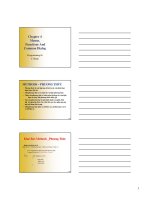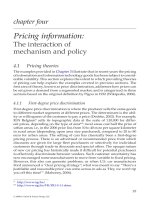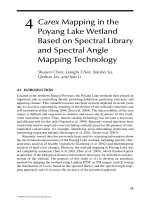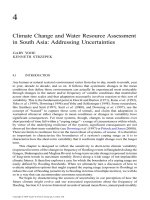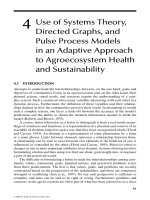chapter 4 individual and maket demand
Bạn đang xem bản rút gọn của tài liệu. Xem và tải ngay bản đầy đủ của tài liệu tại đây (325.18 KB, 59 trang )
Chapter 4
Individual and
Market Demand
Chapter 4 Slide 2
Topics to be Discussed
Individual Demand
Income and Substitution Effects
Market Demand
Consumer Surplus
Network Externalities
Empirical Estimation of Demand
Chapter 4 Slide 3
Individual Demand
Price Changes
Using the figures developed in the
previous chapter, the impact of a
change in the price of food can be
illustrated using indifference curves.
Chapter 4 Slide 4
Effect of a Price Change
Food (units
per month)
Clothing
(units per
month)
4
5
6
U
2
U
3
A
B
D
U
1
4 12 20
Three separate
indifference curves
are tangent to
each budget line.
Assume:
•
I = $20
•
P
C
= $2
•
P
F
= $2, $1, $.50
10
Chapter 4 Slide 5
Price-Consumption Curve
Effect of a Price Change
Food (units
per month)
Clothing
(units per
month)
4
5
6
U
2
U
3
A
B
D
U
1
4 12 20
The price-consumption
curve traces out the
utility maximizing
market basket for the
various prices for food.
Chapter 4 Slide 6
Effect of a Price Change
Demand Curve
Individual Demand relates
the quantity of a good that
a consumer will buy to the
price of that good.
Food (units
per month)
Price
of Food
H
E
G
$2.00
4 12 20
$1.00
$.50
Chapter 4 Slide 7
Individual Demand
Two Important Properties of Demand
Curves
1) The level of utility that can be
attained changes as we move
along the curve.
The Individual Demand Curve
The Individual Demand Curve
Chapter 4 Slide 8
Individual Demand
Two Important Properties of Demand Curves
2) At every point on the demand
curve, the consumer is maximizing
utility by satisfying the condition that
the MRS of food for clothing equals
the ratio of the prices of food and
clothing.
The Individual Demand Curve
The Individual Demand Curve
Chapter 4 Slide 9
Effect of a Price Change
Food (units
per month)
Price
of Food
H
E
G
$2.00
4 12 20
$1.00
$.50
Demand Curve
•
E: P
f
/P
c
= 2/2 = 1 = MRS
•
G: P
f
/P
c
= 1/2 = .5 = MRS
•
H:P
f
/P
c
= .5/2 = .25 = MRS
When the price falls: P
f
/P
c
& MRS also fall
Chapter 4 Slide
10
Individual Demand
Income Changes
Using the figures developed in the
previous chapter, the impact of a
change in the income can be illustrated
using indifference curves.
Chapter 4 Slide
11
Effects of Income Changes
Food (units
per month)
Clothing
(units per
month)
An increase in income,
with the prices fixed,
causes consumers to alter
their choice of
market basket.
Income-Consumption
Curve
3
4
A
U
1
5
10
B
U
2
D
7
16
U
3
Assume: P
f
= $1
P
c
= $2
I = $10, $20, $30
Chapter 4 Slide
12
Effects of Income Changes
Food (units
per month)
Price
of
food
An increase in income,
from $10 to $20 to $30,
with the prices fixed,
shifts the consumer’s
demand curve to the right.
$1.00
4
D
1
E
10
D
2
G
16
D
3
H
Chapter 4 Slide
13
Individual Demand
Income Changes
The income-consumption curve traces
out the utility-maximizing combinations
of food and clothing associated with
every income level.
Chapter 4 Slide
14
Individual Demand
Income Changes
An increase in income shifts the budget
line to the right, increasing consumption
along the income-consumption curve.
Simultaneously, the increase in income
shifts the demand curve to the right.
Chapter 4 Slide
15
Individual Demand
Income Changes
When the income-consumption curve
has a positive slope:
The quantity demanded increases
with income.
The income elasticity of demand is
positive.
The good is a normal good.
Normal Good vs. Inferior Good
Normal Good vs. Inferior Good
Chapter 4 Slide
16
Individual Demand
Income Changes
When the income-consumption curve
has a negative slope:
The quantity demanded decreases
with income.
The income elasticity of demand is
negative.
The good is an inferior good.
Normal Good vs. Inferior Good
Normal Good vs. Inferior Good
Chapter 4 Slide
17
An Inferior Good
Hamburger
(units per month)
Steak
(units per
month)
15
30
U
3
C
Income-Consumption
Curve
…but hamburger
becomes an inferior
good when the income
consumption curve
bends backward
between B and C.
105 20
5
10
A
U
1
B
U
2
Both hamburger
and steak behave
as a normal good,
between A and B
Chapter 4 Slide
18
Individual Demand
Engel Curves
Engel curves relate the quantity of good
consumed to income.
If the good is a normal good, the Engel
curve is upward sloping.
If the good is an inferior good, the Engel
curve is downward sloping.
Chapter 4 Slide
19
Engel Curves
Food (units
per month)
30
4 8 12
10
Income
($ per
month)
20
160
Engel curves slope
upward for
normal goods.
Chapter 4 Slide
20
Engel Curves
Engel curves slope
backward bending
for inferior goods.
Inferior
Normal
Food (units
per month)
30
4 8 12
10
Income
($ per
month)
20
160
Chapter 4 Slide
21
Individual Demand
1) Two goods are considered
substitutes if an increase
(decrease) in the price of one
leads to an increase (decrease) in the
quantity demanded of the other.
e.g. movie tickets and video rentals
Substitutes and Complements
Substitutes and Complements
Chapter 4 Slide
22
Individual Demand
2) Two goods are considered
complements if an increase
(decrease) in the price of one
leads to a decrease (increase) in the
quantity demanded of the other.
e.g. gasoline and motor oil
Substitutes and Complements
Substitutes and Complements
Chapter 4 Slide
23
Individual Demand
3) Two goods are independent when a
change in the price of one good has no
effect on the quantity demanded of the
other
Substitutes and Complements
Substitutes and Complements
Chapter 4 Slide
24
Income and Substitution Effects
A fall in the price of a good has two
effects: Substitution & Income
Substitution Effect
Consumers will tend to buy more of
the good that has become relatively
cheaper, and less of the good that is
now relatively more expensive.
Chapter 4 Slide
25
Income and Substitution Effects
A fall in the price of a good has two
effects: Substitution & Income
Income Effect
Consumers experience an increase
in real purchasing power when the
price of one good falls, thus
increasing consumption.



